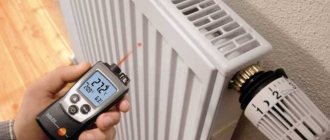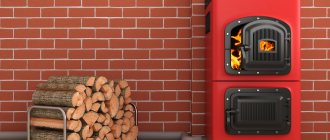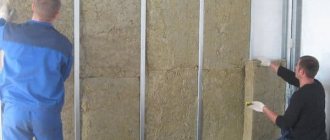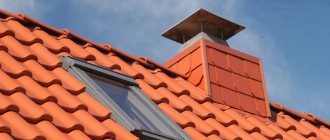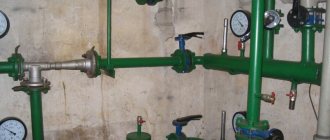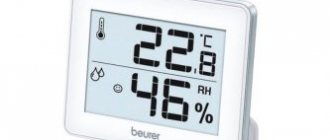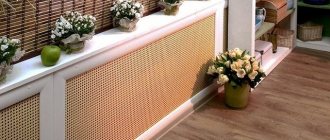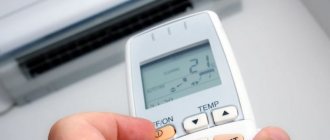Optimal humidity level for a children's room
Knowledge of some important features of maintaining humidity at the correct level and basic medical recommendations will help protect yourself and your child from the negative effects on the well-being of high and low air humidity, and protect family members from diseases that arise from improper distribution of air flows in the apartment.
All apartments require different levels of air humidity. An office, a warehouse, a balcony, a bathroom, a kitchen or a children's room - each of these rooms will have its own humidity standards.
A children's room is a place for the child to stay awake, relax, sleep, and play all kinds of games. Children spend a lot of time in it.
To avoid overheating and intense sweating, you should ensure access to fresh, humid air in the room during intense games and physical activity. Sufficiently humid air also promotes the child’s mental activity, brain function will be more productive, and concentration will be higher. The child will not be distracted, quenching his thirst every few minutes.
When the air is too dry, less oxygen reaches the brain, which leads to fatigue, irritability and apathy.
The humidity criterion is especially important for the sleep of children of all ages. While we are sleeping, we have no control over the level of moisture, but it is directly related to comfort and quality of dreams. For deep and restful sleep, the room requires a special atmosphere: it should not be stuffy or too hot.
In uncomfortable conditions, the child will wake up, toss and turn and throw away the blanket. This will also lead to irritation of the nasal mucosa and difficulty breathing.
But the cold can cause no less inconvenience. It forces you to subconsciously look for a source of heat to keep warm. In this case, sleep is likely to be superficial and restless. This can also create favorable conditions for the development of acute respiratory diseases, which over time can develop into chronic ones, incl. and such as asthma or bronchitis.
Increased moisture promotes the growth of mold, pathogenic bacteria and fungus. This leads to allergic reactions that develop into chronic respiratory diseases.
The ratio of air parameters affects the condition of the skin and eye membranes. There are skin diseases that are directly related to insufficient hydration (for example, atopic dermatitis).
All these points give reason to think about the optimal level of moisture in the air in a child’s room. There are general parameters that will indicate the optimal temperature and humidity in the children's room. These criteria are approved by pediatricians.
In world medical practice, it is generally accepted that this figure for children should be 40-60%. The parameter is constant, independent of seasonality, i.e. both winter and summer are the same. In this case, the temperature in the room should be maintained at a constant level of +22°...+24°C.
Remember that 40-60% is the normal air humidity in the apartment for a child in a healthy state. If there is a child suffering from a respiratory disease in the house, the optimal air humidity rises to 60-70%. This prevents nasal congestion and drying out of the mucous membranes. Recovery will be faster if you follow these recommendations.
Air in the children's room.
Almost all books and textbooks on child care draw attention to the obvious fact that the baby's body temperature regulation mechanisms are imperfect, and therefore there is a high risk of hypothermia. From this, in general, absolutely correct position, absolutely wrong conclusions are often drawn[1]. Protecting your baby from hypothermia is given top priority, to the point that purchasing an electric heater is one of the most mandatory steps when preparing to welcome a newborn. If, as we have already mentioned, the air temperature in the newborn ward of the maternity hospital should, in accordance with the instructions, be no lower than 22 ° C (as a rule, it is higher), then fearful parents will strive at all costs to keep it below this figure. (the temperature) hasn’t dropped at all. The author visited hundreds of newborns in the first days after their discharge from the hospital, and the feeling of shortness of breath was the most constant and most typical of all the feelings he experienced after a short stay in the nursery.
Panicically afraid of the cold, parents often don’t even think about the fact that the imperfection of thermoregulation mechanisms we mentioned is fraught not only with hypothermia, but also with overheating.
Metabolism in a newborn is very intense and is accompanied by the production of a significant amount of heat. The child’s body needs to get rid of this heat. This can be done in two ways - through the lungs and through the skin (direct heat transfer upon contact of two environments with different temperatures plus evaporation of sweat).
The air inhaled by a person (a newborn is no exception), reaching the lungs, heats up to body temperature. That is, the child inhales air with a temperature of 18 °C, and exhales, respectively, 36.6 °C. In this case, of course, a certain amount of heat is lost. If the temperature of the inhaled air is 23 ° C, then it is obvious that heat loss is noticeably reduced. But you have to lose heat! And the child activates the second way of loss - through the skin. It is necessary to form sweat[2], which is not only wet, but also salty - this means that water and salts are lost, and the newborn’s reserves of both are very small.
Even with a slight lack of fluid, the functioning of all systems and organs is significantly disrupted. And you will definitely discover the consequences of these violations when you turn the child around. Overheating organized in the maternity hospital (as long as you don’t say that you have a cold) is first of all visible on the skin of your newborn - it is bright red, in those places where sweat accumulates (in the groin, for example), there is diaper rash[3]. The baby is bloated and his tummy hurts (thick intestinal juices due to lack of fluid are difficult to digest food), there are white spots in the mouth: thrush[4] (thick saliva due to lack of fluid does not perform its functions), in the nose - dry crusts that make breathing difficult (sometimes he can’t even suck), etc.
Regulating the temperature of a newborn can be accomplished by solving two problems:
1) air temperature in the children's room;
2) child’s clothes.
Both of these problems must be solved immediately, on the very first day after returning from the hospital. The longer you take to get together and decide, the worse it will be for you and your baby, the greater the efforts you will subsequently need to catch up.
It is extremely important (!!!) not to confuse or confuse such concepts as “the child is cold” and “the temperature of the air that the child breathes.”
The optimal temperature in a child's room is 18-19 °C.
The higher, the worse. But for the rest of your life – both yours and your child’s – you need to remember the most important rule that allows you to make the right decision when in doubt [5]:
IT'S BETTER TO OVERCOOL THAN OVERHEAT
Only this way and not otherwise, because we cannot, in no case should we forget that overheating of a child is no less, and, as a rule, much more dangerous than hypothermia!
Natural conditions usually allow you to create an optimal temperature regime (18-19 ° C), but there are exceptions, and they are not uncommon. A child may be born in the hot season, in a country with a hot climate, in a city where heating system workers tend to be more diligent in their duties, etc.
You can protect your child from overheating at high room temperatures (above 22 °C) by acting in three directions:
1) clothing, or rather the minimum amount of it;
2) sufficient intake of liquid into the child’s body, in addition to milk (water);
3) bath.
We will go through all these areas in detail in the future.
Another factor - no less significant in comparison with the temperature in the children's room - relative air humidity .
The relevance of this parameter is extremely high specifically for children, and this is all connected with the same features of thermoregulation of infants that we previously mentioned. The exhaled air has body temperature and humidity of 100%. The drier the inhaled air, the more fluid the child’s body spends to hydrate it, and we have already reported what additional water losses lead to.
Most readers of this book live in very specific climatic conditions, when there is a heating season for at least six months (from October to April at best), and a fundamental feature of almost all heating systems is the drying of air in residential premises.
The optimal relative humidity in a children's room is 50-70%.
Heating the air, as a rule, leads to the fact that its humidity is on average two times lower than recommended. And the more the child’s relatives are concerned about the risk of freezing, the more actively the children’s room is heated - the drier the air, the higher the likelihood of health problems for the baby: drying out of the mucous membranes of the respiratory tract (coughing, snorting), skin problems, thickening of the blood, etc. d.
The conclusion is obvious: controlling indoor air humidity and maintaining it at the proper level is the most important parental task . Frequent wet cleaning, open containers with water, spray bottles, decorative fountains, and an aquarium are options for solving this problem. Modern technologies make achieving goals less labor-intensive. The child’s relatives should at least know that there is such a simple, not particularly expensive and very effective contraption called a household air humidifier (they are steam and ultrasonic; the latter are quieter and safer).
***
Now let’s pay attention to such a surprising phenomenon from an everyday point of view as a draft[6].
“ DRAFT - a through wind, a stream of air blowing through the room”[7].
I wonder who was the first to come up with the idea that Nature could create a biological species for which a stream of air poses a formidable danger?
Dear people! You and I are afraid of drafts, because our parents protected us in every possible way from these same drafts. But what does the baby have to do with it? Of course, there is no need to go too far, but there are constant shouts: “Close the door quickly!” don't lead to anything good. The child is afraid of the unknown. And you can’t live your life without ever encountering a draft. So it’s better to get to know him in infancy, having ceased to be afraid, than to shout at the whole bus as an adult and respectable man: “Close the window, it’s drafty!”
From the moment you return from the maternity hospital, do not pay attention to whether the door to the room where the child is open or closed. It does not matter, from the point of view of his health, where the bed is located and whether air enters it from a slightly open window. For a five-year-old child, already spoiled by the desire to protect him, it has. But for a newborn - no.
[1] These conclusions, as a rule, are made not by the authors of books and textbooks, but by parents.
[2] The sweat glands of a newborn are poorly developed, i.e., he is adapted by Nature to lose heat precisely through breathing.
[3] Diaper rash is an inflammation of the skin that occurs mainly in its folds.
[4] Thrush is an inflammation of the oral mucosa caused by yeast-like fungi.
[5] It is necessary to put this rule into practice, of course, not at the age of five or ten, but from the moment of birth.
[6] For some reason, it seems to the author that most readers do not have air conditioning or artificial climate control systems. An open window is the most common technical device for reducing the air temperature in a room. Talking about drafts in this case may be quite appropriate.
[7] Definition from the Dictionary of the Russian Language by S. I. Ozhegov, M.: Russian Language, 1984.
author Komarovsky E.O. book Child's health and the common sense of his relatives published 02/26/2010 16:57
How and with what to measure air humidity
You can measure the level of humidity in the air with a special device - a hygrometer. Now manufacturers of household medical equipment offer entire lines of different hygrometers with additional functions - a thermometer, a clock, an alarm clock.
Their design and functionality differ between brands. There are mechanical, condensation, and weight hygrometers. Each of them has its own advantages, but there are also disadvantages: low accuracy, inconvenience of use, large weight or volume of the device.
When choosing a hygrometer, focus primarily on the accuracy of its readings and the speed of response to changes in parameters. The most modern hygrometers are electronic. They have the following properties and advantages: accuracy, compactness, ease of use, beautiful design, additional functions, the ability to be placed both horizontally and vertically.
The electronic hygrometer has a convenient and understandable dial; it automatically adjusts the humidity levels in the surrounding air as quickly as possible after they change. It can additionally display temperature and even time.
We recommend installing the device directly between the sleeping place and the heating elements in the child’s room. This way the moisture level will be measured more accurately.
If you don’t have a hygrometer at hand, and you don’t want to spend money on buying one, or you need to measure the humidity of a new room once (for example, in a hotel or while visiting), you can use other methods.
Assmann table
This method is based on imitating the operation of a device called a psychrometer. These are two thermometers that show different temperature levels. In order to make a similar device at home with your own hands, you can take a thermometer to measure air.
Measure the initial temperature in the room. Then take a wet cloth and wrap it around the end of the thermometer. Wait 5-10 minutes. Look at the temperature indicator. Subtract the difference between the indicators.
These two parameters need to be compared with the Assmann table, obtaining a result about the optimality of the air.
The method is quite approximate in determining the moisture level, and you also need to have a table at hand. If it is not possible to use tabular values, use the water in a glass method.
Glass of water
The method of measuring the moisture level using a glass cannot be called extremely accurate, but with its help you can determine the approximate level without leaving home.
To carry out the experiment, you need a glass, chilled water and a refrigerator.
Pour a small amount of water into a glass. Then place it in the refrigerator for 3-4 hours so that the water in the glass cools to 3-5°C.
Take out the glass and place it in the room where you plan to measure the humidity. If the glass is covered with sweat and fogged up, and then the water dries up in a few minutes, then the air in the room is quite dry.
If after a few minutes drops of condensation settle on the surface of the glass and begin to flow along the walls, this means that the air humidity in the nursery exceeds the normal level.
If after 5-10 minutes the perspiration on the glass has not dried or flowed, then this is evidence of a normal level of humidity in the nursery.
It must be remembered that the experiment must be carried out by placing the glass away from heating devices and equipment that heat up.
The readings of this test are quite approximate and may fluctuate if all testing conditions are not met.
Spruce cone
This method is quite simple. The scales of cones can be perceived as a natural hygrometer; they depend on moisture and respond to its changes in the atmosphere.
Place the dry bud in a room away from heat sources and leave for several hours.
Then take a closer look at the scales. If they are pressed tightly to the base of the cone, it means that there is a lot of moisture in the room, its level is too high. If the scales open over time, this is evidence that the air is dry. If the lump remains the same, the moisture in the room is at the optimal level.
How to measure humidity in a nursery?
You can determine the level of humidity in an apartment, including a nursery, using a psychrometric hygrometer . It is usually hung on the wall in the nursery. On the body of the device there are two thermometers and a table for determining relative humidity.
One thermometer shows the real temperature in the room (you can find out about its optimal readings here). The tip of another thermometer is wrapped in a constantly moistened strip of cloth. The difference between the temperature values is used to determine exact relative humidity.
Modern electronic hygrometers have a small body; they can be installed on a coffee table or bookshelf, or moved to other rooms. The device screen displays the temperature and humidity values in the room; in addition they can display time and atmospheric pressure.
Some devices
have a memory function and can record changes in readings over a period of time.
The hygrometer should always be in the children's room. The accuracy of the instrument readings cannot be replaced by any approximate calculations using available means. Optimal microclimate parameters are very important for the normal development of a child.
[rek_custom1]
How to humidify the air
After measuring air humidity standards in an apartment for a child and identifying discrepancies, the next step should be to stabilize the parameters at the normal level.
If, according to the results of measurements, the air humidity in the children's room is below normal, you can increase it using several simple methods:
- Minimize the use of all heating and air-drying appliances. In winter, you can wrap the batteries with fabric to trap some heat.
- Perform wet cleaning several times a day - the air humidity in the room will increase.
- Place pots of flowers in the room and spray them regularly with a spray bottle.
- Ventilate the room and place several tanks of cool water, one of them near the heater, if you want to regulate the humidity during the winter.
There are also more expensive methods to increase the humidity in the nursery. Buy a small home aquarium, this will promote moisture and create additional comfort.
You can purchase a professional humidifier in the store. Their variety will satisfy any need. Their price also varies and you can buy both a budget and an expensive model.
The danger of indoor humidity imbalance
From all of the above, we can confidently conclude that insufficient and high humidity in the room has a negative impact on the health and well-being of the baby. With elevated levels, the child gets sick more. And with insufficient humidity, the mucous membranes of the baby and his skin are the first to suffer. All this can cause a lot of pathological conditions that require qualified treatment.
- Skin problems. Since newborn babies have dry skin, it is prone to cracking and peeling. Dry air in the apartment negatively affects the skin and contributes to its irritation.
- Allergy. Children suffering from allergic reactions, inhaling dry air, receive a “push” to worsen their problems. Quite often in such situations, atopic dermatitis develops.
- Problems with mucous membranes. The mucous membranes are very sensitive to the level of humidity in the room. Dry air in the apartment causes nasal congestion, as a crust forms on the mucous membranes. At this moment, the child not only begins to sniff loudly, as if grunting, but also cannot eat and sleep normally. After all, a stuffy nose causes a lot of problems even in adults.
How to reduce air humidity
In case of high humidity, you can reduce it in several ways:
- You can turn on the room heater for 15-20 minutes several times a day.
- In order for high humidity to become normal, ventilate the room daily and do not dry washed clothes in the nursery.
Other ways to improve the microclimate in a room involve some monetary costs. Purchase and place special tablets in the room to absorb moisture. You can buy an air dehumidifier, and then the problem will go away within a few hours of operation of the device.
Air humidification devices
Salts in the urine of a child under one year old - normal and increased levels
Optimal air humidity in an apartment for a child can be maintained using improvised means or special devices. There are several models, which differ in their operating mechanism:
- Using cold steam. The disadvantage of such a device is that it requires the use of distilled water, since tap water will lead to rapid clogging.
- Ultrasonic devices. They cover large areas. Control is carried out by remote control.
- Steam humidifiers that work on the principle of hot steam. They almost always have hygrometers built into them.
You can install a special device in the child’s room
If it is not possible to buy a special device, then you can increase the humidity level in the room using improvised means:
- pots with indoor flowers, which are regularly sprayed with a spray bottle;
- place containers of water in the room or hang wet things.
These simple steps will help you quickly get rid of dry air.
How to Maintain Humidity Levels for a Newborn
The moisture level in the air for a baby is one of the most important parameters for harmonious development and maintenance of health. Newborns tolerate all atmospheric changes more difficult than adults.
A very young child does not have a developed thermoregulation system; the concepts of cold and stuffiness are incomprehensible to him. All responsibility for maintaining the microclimate in this case lies with the parents:
- Too dry air forces the child’s body to accumulate strength for increased sweat production. If there is excess humidity, children may develop an allergic reaction to fungus and mold that multiply in such conditions.
- If you have a newborn in your home, the best option would be to purchase a hygrometer and constantly monitor the humidity in the baby's room.
- Based on the results of observations, it will be clear whether there is a need to purchase a humidifier or dehumidifier.
- Carry out regular wet cleaning and ventilation. Place a container of water next to the battery; it will absorb excess dryness.
- The temperature in the baby's room can vary from 20°C to 22°C. This will be optimal to avoid the slightest possibility of overheating.
- Monitor the condition of the child himself - give him food on time, bathe him, change clothes according to the season.
By following the recommendations and fulfilling medical prescriptions, parents can effectively regulate the level of humidity in the apartment and thereby protect the child from many related health problems.
Ideal temperature and humidity: creating optimal conditions
Comfortable humidity and air temperature in the room of a small newborn must be created correctly, focusing on the season. So, in the summer, you can install an air conditioner to regulate air parameters. It is only important not to direct cold streams directly to the baby's crib.
The temperature both in the children's room and in the room for adults depends on the beginning of the heating season. If it has not yet arrived, and the house is cold, parents are advised to purchase a heater. In winter, it is extremely difficult to follow the standards, since the premises become overheated and “dry out”.
In order for temperature standards to come into order, experts advise adhering to certain recommendations, which should be discussed in more detail.
Ventilation of the room
Fresh air is extremely beneficial for any child, so it is necessary to ventilate the room every four hours.
Optimal humidity and temperature for sleep are especially important, otherwise it will be impossible to rock the baby normally and put him to sleep.
When ventilating the nursery, the newborn must be taken to another room.
This helps not only to optimize temperature and humidity, but also to saturate the room with oxygen. Another option is to go for a walk with your child.
Closing the battery
If central heating radiators are too hot and it is impossible to reduce the heating level, it is recommended to cover them with special wooden or plastic shields. You can also hang a thick cloth over the batteries.
Getting rid of canopies
A canopy crib is a very cute and aesthetically attractive structure. However, beautiful curtains can limit the child's access to oxygen, which leads to an increase in body temperature. To ensure free flow of air, it is best to get rid of the canopy or remove it while the child sleeps.
Carpets are a known dust collector and should be avoided too. In addition, it is worth getting rid of excess furniture, since clutter also disrupts the normal air circulation in the room.
Choosing the right clothes
The correct selection of clothes and bedding is important for a child. It is important to stop wearing synthetic products for newborns. The skin in them does not breathe, therefore, the thermal regulation of the baby’s body is disrupted. It’s better to avoid wearing a hat altogether.
In addition, you should not wrap your baby up if the room is hot, and expose him if the room temperature is low. Well, things made from natural fabrics will help create optimal conditions for restful sleep and active wakefulness.
More frequent feeding
If your newborn baby is too hot, shortening the interval between meals may help.
It is known that breast milk contains 80% water, which means that breastfeeding quenches thirst and optimizes fluid levels in the body. If your baby is fed formula, you can supplement him with water using a bottle between meals.
It is important to ensure that the liquid is at room temperature.
Washing
In summer it is extremely difficult to provide optimal conditions; the child is hot and dry. In this case, you need to bathe the baby up to three times a day, but not for the purpose of cleanliness, but to improve well-being. Naturally, there is no need to use detergents.
Increase in humidity
As already noted, humidified air is no less important for a newborn than optimal temperature conditions. You can create comfortable conditions using technical devices or improvised means.
Experts advise:
- install a special air humidifier;
- carry out wet cleaning of the premises more often;
- place containers with water, fountains near the child or batteries;
- spray water using “sprinklers”;
- cover radiators with damp towels or sheets.
The air temperature in a newborn baby’s room is an important condition for well-being, health and emotional state. Do not forget to monitor the state of the environment, and the baby will develop without any problems, to the delight of the parents.
